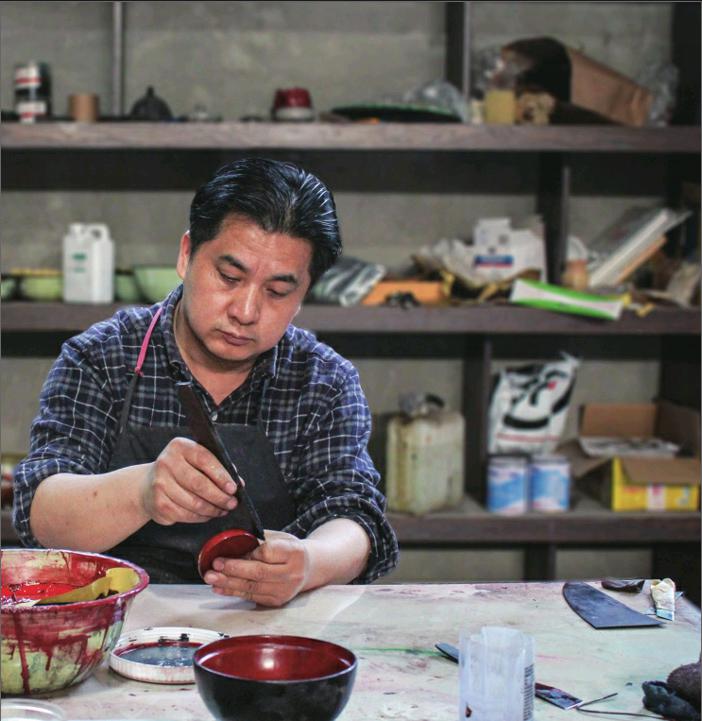A Fresh Lacquer On Tradition
2017-06-22ByMaLi
By+Ma+Li

As soon as the first ray of sunshine pierces through the air in southeast Chinas Fujian Province, a lacquerware workshop opens its doors for business.
The workshops owner is Li Changmin. He is a senior lacquer artist and a second generation practitioner of Fuzhou bodiless lacquerware art, which was listed as a part of the nations intangible cultural heritage in 2006.
The lacquerware is made with linen, gold and silver and often involves the use of numerous processes to create the finished product. Bodiless lacquerware is one of the most delicate art forms developed in Fuzhou and has more than 1,000 years of history.
Today, due to the support of the Belt and Road Initiative, Li Changmin and his son Li Qiang are working hard to revive the traditional art form.
Innovating tradition
The Li family live in the village of Gushanzhou in Jingxi Township in Fuzhous Minhou County. For hundreds of years, the village has been famous for its lacquerware art. Some local families have developed their own art styles and passed them on through generations. Many folk lacquerware masters have been trained in the village, and Li Changmin is one of them.
Bodiless lacquerware is considered to be one of the “three treasures” of traditional Chinese crafts, which also include Beijing cloisonné and Jingdezhen porcelain. Since 1910, bodiless lacquerware has been shown at many international exhibitions and won prizes and accolades. Items made this way have been dubbed “precious dark gems” and “oriental treasures.”
Li began to learn the skills needed to make bodiless lacquerware from the age of 15, when he was allowed to learn from his uncle Li Zhenrong, a renowned lacquerware master at the time.
In the late 1980s, state-operated lac- querware factories were closed down one after another due to bad performance. A large number of lacquerware workers were laid off and many of them eventually gave up their careers in the industry.
Li Changmin is one of the few who decided to persist. “If we all left the industry, the traditional art form would vanish. It would be a pity for everyone,” Li said. In spite of intense opposition from his family, Li gathered many former colleagues and set up the market-oriented Minhou County Minxin Craft Factory. He vowed to keep the traditional art form alive. The factory wins lots of orders from Japanese and South Korean companies due to constant innovation.
In 1995, when his business was getting better and better, Li made an unexpected decision to go to Japan to learn new techniques in making lacquerware.“I was fascinated by Japans lacquerware techniques. Their lacquer was non-toxic and odorless, which made their wares well received among families and regarded as family heirlooms. But for Chinese families, lacquerware is only seen as dispensable decoration,” Li said.
After one year of study, Li succeeded in extracting 43 new sorts of raw lacquer pigments, all non-toxic and odorless. Meanwhile, the study and communication in Japan also gave Li a chance to make himself known to his Japanese peers. Due to this connection, many Japanese individuals and companies buy lacquerware from Lis workshop, including Nippon Telegraph and Telephone, which has been a regular customer of Lis company for the past 17 years.
When talking about his decision to set up a factory to take in laid-off workers and artists, Li said, “It was the best way to preserve the technique at the time. Workers and artists only had extra energy and time to do art and to train apprentices when they felt that their livelihood was secure.” In the past more than 30 years, Li himself has trained more than 100 apprentices.
Li has also invited artists Gao Konghao and Li Changguang to provide advanced instruction for the lacquering, polishing and burnishing processes. After reading a mass of documents and fi les, Li combined the two masters skills as well as his uncle Li Zhenrongs “clear lacquer grinding” process to create a new technique—“golden worm” craft. The craft requires casting some rice hulls to the product after lacquering, removing the hulls after half an hour, then polishing and burnishing the article. Such lacquerware has a shining surface with subtle and delicate markings.
In 2012, Lis son Li Qiang graduated from university and got a job at a bank. Two years later, Li Qiang quit the dream job and started learning how to make lacquerware with his father. He said he was moved by his fathers persistence in preserving the traditional art.
With his professional knowledge in ebusiness, Li Qiang set up an online store in 2014 to sell lacquerware produced by his fathers factory all over China. Meanwhile, feedback from buyers also made Li Qiang realize the shortcomings of his fathers products—they may be high-quality, but the styles used are out of date.
Li Qiang therefore helped his father modify the style and pattern designs of their products. Without affecting quality, they integrated modern and abstract styles into the traditional art, which then made their lacquerware more popular among consumers.
Like mother, like son
Ou Rurong was born in the old town of Fujians Putian City. It is her family tradition to collect well-designed lacquerware, which could only be afforded by well-off families in former times.
“I often go to exhibitions to collect lacquerware. In 2013, I was fascinated by the products made by Li Changmin at an exhibition,” Ou said.
Ou Rurong and Li Changmin soon became good friends. In the summer of 2014, when Ou and her son Ou Yu, who was studying in Australia, came to Lis workshop, Ou Yu and Li Qiang also established a relationship.
“When I was studying in Australia, I was inspired by ornaments from world-class brands. I believe our lacquerware can also be made into small ornaments like rings, bracelets and necklaces to be sold around the world,” Ou Yu said.
Ou Yu then started thinking about setting up a company to introduce Fuzhou bodiless lacquerware to the world. In 2016, the Fuzhou Red and Purple Lacquer Cultural Development Co. Ltd. was jointly established by Ou Yu and Li Qiang.
“Red and purple are the most beautiful colors in lacquer pigments, so we named our company after those colors,” Ou Yu said.
“Our goal is to adapt the traditional art form to modern lives. In addition to lacquerware, we will endeavor to create high-end ornaments for consumers around the world,”Ou added.
A common cause
Lacquerware links the Li and Ou families together. “Our common goal is to popularize the traditional craft in average households,”Ou Rurong said.
In Li Changmins eyes, lacquerware can also be used in everyday life. “They can be designed and made through combinations with other materials like bamboo, cloth, stone or leather. We must innovate our designs in order to preserve the craft,” Li said.
Today, Li is attempting to incorporate the art form into daily items such as furniture, tea sets, cell phone cases and car ornaments. “When lacquerware is in demand, the tradition will live on,” Li Qiang said.
Ou Yu said that the domestic market is their principal target at the moment. Meanwhile, he said they will also establish an online platform for people interested in the craft, including artists and workers, to show and trade their talent and products. “Through the platform, consumers will be able to order tailored lacquerware according to their own needs,” Ou Yu said.
According to Ou Yu, lacquerware trade will fl ourish on such a platform in the future.
